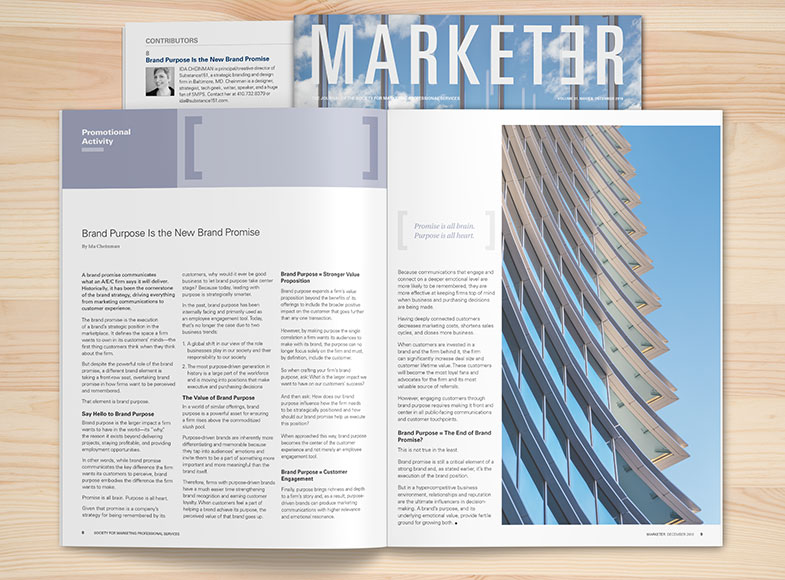
This article was first published in the Marketer – Journal of the Society for Marketing Professional Services (SMPS).
The execution of a brand’s strategic position in the marketplace, the brand promise defines the space a company wants to own in its customers’ minds, the first thing it wants customers to think when they think about the company.
But despite the powerful role of the brand promise, a different brand element is taking a front row seat, overtaking brand promise in how companies want to be perceived and remembered.
That element is brand purpose.
Brand purpose is the larger impact a company wants to have in the world – its “why,” the reason it exists beyond delivering projects, staying profitable, and providing employment opportunities.
In other words, while brand promise communicates the key difference the company wants its customers to perceive, brand purpose embodies the difference the company wants to make.
Promise is all brain. Purpose is all heart.
In a world of similar offerings, brand purpose is a powerful asset for ensuring a company rises above the commoditized slush pool.
Purpose-driven brands are inherently more differentiating and memorable because they tap into audiences’ emotions and invite them to be a part of something more important and more meaningful than the brand itself.
Therefore, companies with purpose-driven brands have a much easier time strengthening brand recognition and earning customer loyalty. When customers feel a part of helping a brand achieve its purpose, the perceived value of that brand goes up.
Because brand promise differentiates at the level of offerings, it leads to a value proposition limited to the tangible benefits of company’s services or products.
Brand purpose, however, expands a company’s value proposition beyond the benefits of its offerings to include the broader positive impact on the customer that goes further than any one transaction.
In short, a purpose-driven value proposition delivers a more wide-ranging value.
However, by making purpose the single correlation a company wants its audiences to make with its brand, the purpose can no longer focus solely on the company and must, by definition, include the customer.
So when crafting your company’s brand purpose, ask: What is the larger impact we want to have on our customers’ success?
And then: How does our brand purpose influence how the company needs to be strategically positioned and what should our brand promise be to help us execute this position?
When approached this way, brand purpose becomes the center of the customer experience and not merely an employee engagement tool.
Finally, purpose brings richness and depth to a company’s story, and as a result, purpose-driven brands have the ability to produce marketing communications with higher relevance and emotional resonance.
Because communications that engage and connect on a deeper emotional level are more likely to be remembered, they are more effective at keeping companies top of mind when business and purchasing decisions are being made.
But it gets better still.
First, having deeply connected customers helps to decrease marketing costs, shorten sales cycles, and close more business.
Second, when customers are invested in a brand and the company behind it, the company can significantly increase deal size and customer lifetime value, and the customers will become the most loyal fans and advocates for the company and its most valuable source of referrals.
However, engaging customers through brand purpose requires making it front and center in all public-facing communications and customer touchpoints.
Not in the least.
Brand promise is still a critical element of a strong brand, and as stated earlier, it’s the execution of the brand position.
But in a hyper-competitive business environment, relationships and reputation are the ultimate influencers in decision making. A brand’s purpose, and its underlying emotional value, provide fertile ground for growing both.
Do You Understand the Anatomy of Your Brand?
Anatomy of a Brand [infographic]
The Bigger Truth About Purpose-Led Brands (Why “Why” Is Not What You Think It Is)
For more resources to help you navigate a complicated world of brand building, visit Rebranding Resource Center for Busy Marketers and Company Leaders.
Building a strong brand is anything but easy. To assist you with the entire process – from conducting your brand audit through rebranding, we’ve developed this Brand Toolbox.